New London School Explosion. (original) (raw)
East Texas has had more than its share of disasters -- the Galveston hurricane of 1900 and the industrial explosions in Texas City in 1946 are examples -- but the day the school house in New London blew up has a singular pathos because so many of its victims were children.
New London is located in Rusk County in the oil patch. Wealth from the EasTex field enabled its residents to erect one of the most modern school buildings in the state.
Now London High School before explosion
Photo courtesy texasoldphotos.com
By 3:05 P.M. on March 18, 1937, the school day had nearly ended. Younger grades had been dismissed and some youngsters waited on school buses for older students to join them for the ride home. Some students still in the building practiced for Interscholastic League competition while others put away materials. A PTA meeting was being held in the adjacent gymnasium. Then industrial arts teacher Lemmie Butler turned on a sander in his shop and a spark ignited natural gas that had leaked from pipes under the school and been trapped in rooms throughout the building.
The building was lifted in the explosion, then crushed into rubble. Residents who lived four miles away heard the explosion, though they were not alarmed at first because such noises often came from the oil field. Those who knew what had happened quickly spread the word, and help came. Governor James Allred sent Texas Rangers and Highway Patrolmen to assist local law enforcement personnel. If alive, victims were rushed to area hospitals; if not, the Texas Funeral Directors Association sent twenty-five embalmers to help in the massive task of preparing the nearly 300 dead for burial.
Scene of London School Explosion
Mar. 18, 1937
Photo courtesy texasoldphotos.com
What had happened? To save a monthly $300 bill for natural gas usage at the school, the school district had tapped into a gas line coming from the field. Natural gas is odorless, so teachers and students in the building were unaware that leaks had allowed it to become trapped in the building. The spark from the sander ignited the gas and the explosion destroyed the school.
However unwise, the practice of using such gas was a common one in the area. The major positive that came from the New London School Explosion was legislation requiring gas companies to add an odor to their product so anyone can determine when natural gas is leaking or not properly utilized.
New London High School and Cenotaph commemorating the disaster
Postcard courtesy www.rootsweb.com/%7Etxpstcrd/
New London's citizens built a new school and in 1939 a cenotaph was erected nearby in memory to the students and teachers who lost their lives in the worst single disaster East Texans ever suffered.
Dec. 9-15, 2001 Column
A syndicated column in over 40 East Texas newspapers
(Archie P. McDonald is Director of the East Texas Historical Association and author or editor of over 20 books on Texas) Published with permission
New London School Explosion Related Articles
- New London, Texas
- New London Museum by Bob Bowman
- New London School Explosion by Archie P. McDonald
Dr. Bobby H. Johnson, my long-time colleague at Stephen F. Austin State University, has written a play based on the New London School Explosion which occurred on March 18, 1937... - Phoenix Bird of Texas by George Lester
"I learned that our museum guide was a survivor of that fateful event. As she talked to us, my memory went back many years ...." New London Area Hotels >
Kilgore Hotels | More Hotels
Books by Archie P. McDonald - Order Here


